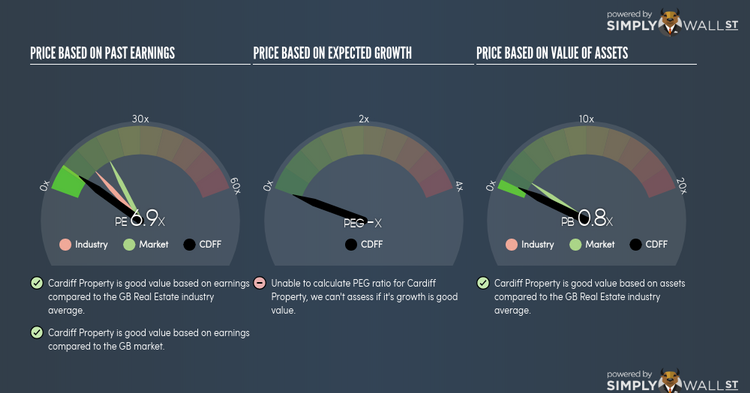Should You Be Tempted To Buy Cardiff Property Plc (LON:CDFF) Because Of Its PE Ratio?

Cardiff Property Plc (LSE:CDFF) is currently trading at a trailing P/E of 6.9x, which is lower than the industry average of 11.9x. Although some investors may jump to the conclusion that this is a great buying opportunity, understanding the assumptions behind the P/E ratio might change your mind. In this article, I will break down what the P/E ratio is, how to interpret it and what to watch out for. See our latest analysis for Cardiff Property
What you need to know about the P/E ratio
P/E is often used for relative valuation since earnings power is a chief driver of investment value. By comparing a stock’s price per share to its earnings per share, we are able to see how much investors are paying for each pound of the company’s earnings.
P/E Calculation for CDFF
Price-Earnings Ratio = Price per share ÷ Earnings per share
CDFF Price-Earnings Ratio = £17.4 ÷ £2.537 = 6.9x
The P/E ratio itself doesn’t tell you a lot; however, it becomes very insightful when you compare it with other similar companies. Our goal is to compare the stock’s P/E ratio to the average of companies that have similar attributes to CDFF, such as company lifetime and products sold. A quick method of creating a peer group is to use companies in the same industry, which is what I will do. At 6.9x, CDFF’s P/E is lower than its industry peers (11.9x). This implies that investors are undervaluing each dollar of CDFF’s earnings. As such, our analysis shows that CDFF represents an under-priced stock.
Assumptions to watch out for
However, before you rush out to buy CDFF, it is important to note that this conclusion is based on two key assumptions. Firstly, our peer group contains companies that are similar to CDFF. If this isn’t the case, the difference in P/E could be due to other factors. For example, if you are comparing lower risk firms with CDFF, then its P/E would naturally be lower than its peers, as investors would value those with lower risk at a higher price. The second assumption that must hold true is that the stocks we are comparing CDFF to are fairly valued by the market. If this does not hold true, CDFF’s lower P/E ratio may be because firms in our peer group are overvalued by the market.
What this means for you:
Are you a shareholder? If your personal research into the stock confirms what the P/E ratio is telling you, it might be a good time to add more of CDFF to your portfolio. But keep in mind that the usefulness of relative valuation depends on whether you are comfortable with making the assumptions I mentioned above.
Are you a potential investor? If you are considering investing in CDFF, basing your decision on the PE metric at one point in time is certainly not sufficient. I recommend you do additional analysis by looking at its intrinsic valuation and using other relative valuation ratios like PEG or EV/EBITDA.
PE is one aspect of your portfolio construction to consider when holding or entering into a stock. But it is certainly not the only factor. Take a look at our most recent infographic report on Cardiff Property for a more in-depth analysis of the stock to help you make a well-informed investment decision. Since we know a limitation of PE is it doesn’t properly account for growth, you can use our free platform to see my list of stocks with a high growth potential and see if their PE is still reasonable.
To help readers see pass the short term volatility of the financial market, we aim to bring you a long-term focused research analysis purely driven by fundamental data. Note that our analysis does not factor in the latest price sensitive company announcements.
The author is an independent contributor and at the time of publication had no position in the stocks mentioned.

